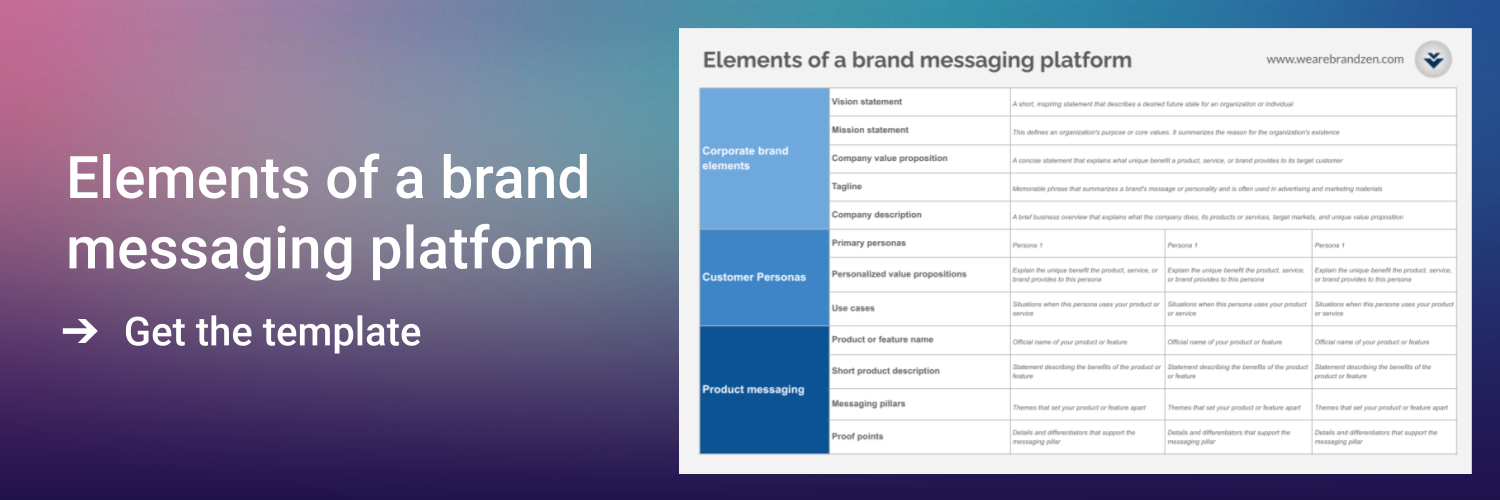Elements of a brand messaging platform
A brand messaging platform aims to define your brand's identity and values to the target audience.
It ensures consistency in messaging across all touchpoints and channels. A consistent brand message is critical to building trust and credibility with your target audience and differentiating your brand from competitors while communicating your unique value proposition.
It also guides all marketing and communication efforts, helping the brand stay on message and communicate effectively with its target audience.
A well-crafted external brand messaging platform is the foundation for all product and brand communication and is essential for building a strong and recognizable brand image.
How to use this guide
This system was designed for startups. It consolidates the three key areas into the essential elements required to build an effective go-to-market plan. This content is typically siloed inside different teams across the organization. By taking a unified view, the company can communicate consistently.
There are three main components to a brand message platform:
1. The corporate brand elements
2. Customer personas
3. Product messaging
1. Corporate brand elements
Vision statement
A vision statement is a short, inspiring statement describing the organization's desired future. It communicates a clear and appealing picture of what the organization wants to achieve and guides decision-making and planning. A vision statement should be aspirational and provide direction for setting goals and objectives.
Mission statement
A mission statement defines an organization's purpose or core values. It summarizes the reason for the organization's existence, what it does, and what it aims to achieve. A mission statement should be brief and inspire confidence in those who read it. It guides employees and stakeholders to understand the organization's priorities and goals and helps ensure everyone is working towards a common purpose.
Company value proposition
A value proposition statement is a concise statement that explains what unique benefit a product, service, or brand provides to its target customer. It identifies the target customer's pain points or needs and then clearly articulates how the product or service solves those problems or fulfills those needs better than the competition. A strong value proposition statement helps a business to differentiate itself from competitors, attract and retain customers, and drive growth.
Tagline
A tagline is a brief, memorable phrase that summarizes a brand's message or personality and is often used in advertising and marketing materials. Taglines are meant to be memorable and convey a brand's value proposition, personality, or tone of voice in a few words. They are typically used with a brand's logo, name, or symbol to help reinforce brand identity. Effective taglines can help to establish a brand's reputation, evoke emotions, and build brand awareness.
Company description
A company description is a brief business overview that explains the company's products or services, target markets, and unique value proposition. It should be concise, clear, and engaging and provide enough information to help the reader understand the business and its goals. A company description provides a snapshot of the business and is often a potential customer or investor's first impression of the business.
→ Read these BrandZen blog posts for details on how to write a value proposition or inspiration for a tagline.
2. Customer personas
Primary personas
The primary persona is a fictional representation of your ideal customer profile (ICP) based on market research and data about the customer's demographics, behavior patterns, motivations, and goals. They help organizations understand their target audience and design more effective marketing and product development strategies.
A customer persona can include their age, income, job title, family situation, education level, interests, pain points, and the solutions they seek.
Personalized value propositions
For each persona, develop a value proposition statement explaining the unique benefit the product, service, or brand provides to them. Identify pain points and explain how the product or service solves these problems or fulfills those needs better than the competition.
Use cases
Describe precisely how each persona uses your product or service. Define the specific use case for each persona. A use case typically includes a step-by-step explanation of the actions taken by the user, the expected results, and the outcome of the interaction.
→ If you want information on writing personas, follow this guide from the Easy Agile blog.
3. Product messaging
Product or feature name
This is the official name of your product or feature. Typically, they all use the same naming system, convention, or system, making them easily recognizable as part of your brand.
Short product description
A short product description should include key features and benefits, plus any technical specifications relevant to understanding how it works and how it is helpful to the customer.
Messaging pillars
Describe the key themes that set your product apart in the marketplace from competitors. These pillars provide a framework for creating consistent, engaging content that aligns with the brand's core values and accurately communicates the value of products.
Proof points
Proof points should be examples or differentiators that offer irrefutable evidence of your product's quality, importance, or uniqueness. They ensure your claims are accurate, convincing, and believable. You should have at least one proof point to support each messaging pillar. You will also want to include data or research to support your claims.
→ For examples of great product messaging, read this post on the Appcues blog.
Putting this all together
Once you have all the essential elements, use this messaging platform to inspire teams to create messaging. This framework will help ensure that your messaging stays consistent and accurate across a wide range of communications channels.
Download the Elements of brand messaging framework Google Slide template here.

